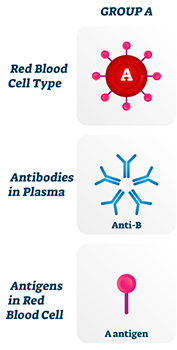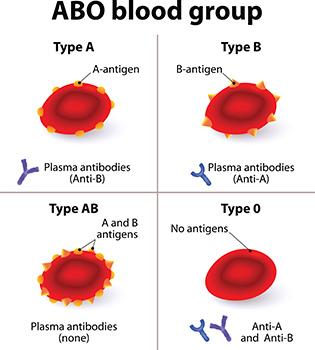Learn
Blood Structure and Function
Blood
The primary function of blood is to transport gases, distribute nutrients, and provide defenses for the body. Blood contains four components:
- Red blood cells
- White blood cells
- Plasma
- Platelets
Red Blood Cells
Red blood cells, also known as erythrocytes, carry oxygen from the lungs to the body's tissue and transport carbon dioxide back to the lungs to be exhaled. On the surface of red blood cells are chemical structures called antigens. These antigens are part of the body's immune response. They signal the immune system to produce antibodies, a protein produced in the plasma in response to a specific antigen, which fight off intruder cells. Antigens located on red blood cells stimulate the body to fight blood cells that may enter the body with the wrong antigens.
Antigens
Antigens determine a person's blood type.
We will focus on ABO blood types and then Rh types.

ABO Blood Types
If you have the "A" antigen on the surface of your red blood cells, you have Type A blood. Type A blood will have "B" antibodies in the plasma. This is how your body recognizes and protects you from any foreign invading blood types.
- If Type A receives Type B blood, an attack will be activated.
- The "B" antibodies in the plasma of the Type A blood will attach to and activate the destruction of all cells containing "B" antigens on their surface (Type B blood).

Agglutination
Could you imagine what would happen if you were low on blood and then given the incorrect blood type? Your antibodies would attack the invading blood, and a reaction called agglutination, or the clumping of blood, would occur, possibly resulting in death. This is why blood transfusions require the correctly matched blood type.

Blood Type Differences
This table illustrates ABO blood type differences. Note the presence (or absence) of antigens for each type, as well as the types of antibodies present in the plasma.

Rh Blood Type
Now, let us look at the Rh blood type. Rh blood type is determined by the presence or absence of the “D” antigen on the surface of red blood cells. If your blood contains this antigen, it is considered “Rh+.” If it does not contain this antigen, it is “Rh-.”

ABO and Rh Together
Together, the ABO and Rh blood characteristics result in 8 different blood types: A+, A-, B+, B-, AB+, AB-, O+, and O-.

Blood Type Summary
All of the blood types are summarized below:
| Blood Type | Antigen Present on RBC Surface | Antibody Present in Plasma |
|---|---|---|
| A | A | B |
| B | B | A |
| AB | A and B | None |
| O | None | A and B both present in plasma |
| Rh- | No Rh "D" antigen | D antibody present in plasma |
| Rh+ | Rh "D" antigen is present | No D antibody |
How to Determine Blood Type
Blood type is determined by adding antibody serums (anti-A, anti-B, and anti-D) to samples of blood. If the blood agglutinates clumps , the blood must contain that antigen.
Knowledge Check #1

" Blood Type O Positive" by biologycorner is licensed under CC BY-NC 2.0.
This blood sample sample shows agglutination when treated with anti-D serum, but not anti-A or anti-B. This means the blood does not contain A or B antigens but does contain Rh (or D) antigens. Therefore, the blood type is _________.
- AB+
- AB-
- O+
- O-
Answer: c. O+. O+ blood does not contain A or B antigens, but does contain Rh/D antigens.
Knowledge Check #2
Which type of blood would clump only when treated with anti-B serum?
- B-
- B+
- A-
- O-
Answer: a. B-. B- blood would clump when treated with anti-B serum.
Blood Type as Evidence
Interestingly, most people secrete blood proteins into other bodily fluids, which means their blood type can be determined from a sample of bodily fluid such as saliva.
Blood type is considered class evidence and can be utilized to eliminate suspects whose blood type differs from that collected at the scene. Because blood types are inherited from both parents, parentage testing by blood groups can be applied to inheritance issues, immigration, baby mix-ups, and paternity cases. While its use has decreased due to the availability of DNA profiling, it is still used in some cases to decrease cost and increase speed of analysis.
Other Components of Blood
White blood cells, also known as leucocytes, help the body fight again disease by destroying bacteria and viruses as they travel through the body. DNA is gathered from white blood cells. Mature red blood cells do not contain DNA.
Platelets, or thrombocytes stop or prevent bleeding by interacting with clotting proteins.
Thrombocytes, lymphocytes, and erythrocytes make up the formed (or solid) portion of the blood. The liquid portion, or plasma, transports these components as well as other materials throughout the body. Recall that antibodies such as “Anti-A” are found in the plasma. It is composed mainly of water.
The diagram below shows the components as well as their relative abundance within the blood.

Knowledge Check #3
Which of these is most abundant in human blood?
- red blood cells
- platelets
- white blood cells
Answer: a. red blood cells. White blood cells and platelets only make up a small portion of blood compared to red blood cells.
Knowledge Check #4
Match the terms to the correct category.
Categories:
- Red Blood Cells
- White Blood Cells
- Platelets
- Plasma
Terms:
- Leucocytes
- Liquid component
- Thrombocytes
- Erythrocytes
- Mostly water
- Contains antibodies
- Carry oxygen and carbon dioxide
- Help to stop bleeding
- DNA is extracted from these
- Contains antigens to determine blood type
- Provide defense against bacteria and viruses
Answers:
| Red Blood Cells | White Blood Cells | Platelets | Plasma |
|---|---|---|---|
| Erythrocytes | Leucocytes | Thrombocytes | Liquid component |
| Contains antigens to determine blood type | DNA is extracted from these | Help to stop bleeding | Mostly water |
| Carry oxygen and carbon dioxide | Provide defense against bacteria and viruses | Contains antibodies |